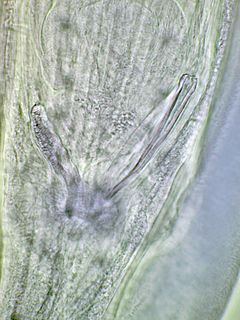 W
WThe alae is a protruding ridge that forms longitudinally on many nematodes. In the Caenorhabditis elegans nematode they are present in the L1, dauer and adult stages. The alae are most pronounced during the dauer larval stage and not present in the L2, and L3 C. elegans stages.
 W
WIn nematodes, the gubernaculum is a hardened or sclerotized structure in the wall that guides the protrusion of the spicule during copulation. For example, in Caenorhabditis elegans, spicules serve to open and dilate the vagina of the hermaphrodite and the gubernaculum is a grooved plate in which the spicules move; the gubernaculum is controlled by two erector and two protractor muscles.
 W
WIn nematodes, spicules, also known as copulatory spicules, are needle-like mating structures found only in males.
 W
WStichocytes are glandular unicellular cells arranged in a row along the posterior portion of the oesophagus, each of which communicates by a single pore with the lumen of the oesophagus. They contain mitochondria, rough endoplasmic reticulum, abundant Golgi apparatuses, and usually 1 of 2 types of secretory granules, α-granules and β-granules, indicating secretory function . Collectively stichocytes form the stichosome. Characteristic of Trichocephalida and Mermithida, two groups of nematodes.
 W
WStichosome is a multicellular organ that is very prominent in some stages of nematodes and consists of a longitudinal series of glandular unicellular cells (stichocytes) arranged in a row along the oesophagus that form the posterior esophageal glands. It opens into the esophageal lumen and apparently functions as a secretory gland and storage organ.
 W
WA sucker in zoology refers to specialised attachment organ of an animal. It acts as an adhesion device in parasitic worms, several flatworms, cephalopods, certain fishes, amphibians, and bats. It is a muscular structure for suction on a host or substrate. In parasitic annelids, flatworms and roundworms, suckers are the organs of attachment to the host tissues. In tapeworms and flukes, they are a parasitic adaptation for attachment on the internal tissues of the host, such as intestines and blood vessels. In roundworms and flatworms they serve as attachment between individuals particularly during mating. In annelids, a sucker can be both a functional mouth and a locomotory organ. The structure and number of suckers are often used as basic taxonomic diagnosis between different species, since they are unique in each species. In tapeworms there are two distinct classes of suckers, namely "bothridia" for true suckers, and "bothria" for false suckers. In digeneal flukes there are usually an oral sucker at the mouth and a ventral sucker posterior to the mouth. Roundworms have their sucker just in front of the anus; hence it is often called a pre-anal sucker.
 W
WThe ventral nerve cord (VNC) is a major structure of the invertebrate central nervous system. It is the functional equivalent of the vertebrate spinal cord. The VNC coordinates neural signaling from the brain to the body and vice versa, integrating sensory input and locomotor output Decapitated insects can still walk, groom, and mate, illustrating that the circuitry of the VNC is sufficient to perform complex motor programs without brain input.